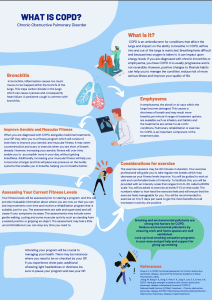The Effectiveness of Exercise Referral Schemes
Physical inactivity (PIA) is responsible for nearly 8% of non-communicable diseases worldwide and 1/6 of deaths in the United Kingdom (UK) (Cunningham et al., 2021; Katzmarzyk et al., 2021). In those who already have a chronic health condition, physical activity (PA) can improve all-cause mortality and disease outcomes yet nearly 40% of the UK population are currently inactive (British Heart Foundation, 2017; Lee et al., 2012). Exercise referral schemes (ERSs) were commissioned in the 1990’s as a solution to PIA but there has been considerable debate as to whether ERSs have been effective (National Institute for Health and Care Excellence (NICE, 2014); Hanson et al., 2020; Pavey et al., 2011). In order to ensure the schemes are effective, evidence supports the standardisation of delivery of the schemes. Without standardisation, there is a risk that they will be decommissioned, at a time where chronic conditions are rising, and a strong solution is required to reduce them.
What are exercise referral schemes; what is the purpose?
When a general practitioner or primary care team refers a patient to a supervised programme of PA, this is called an exercise referral scheme (Williams et al., 2007). The National Quality Assurance Framework (NQAF) was written in 2001 to provide guidelines for the effective use of ERSs (Department of Health, 2001). It was recommended within the guidance, that alongside PA interventions, schemes are most effective when paired with evidence-based behaviour change frameworks (Department of Health, 2001; Watson, 2017).
Are exercise referral schemes effective?
Early research supports efficacy of ERSs but there is concern as to whether they are effective in the short and long term (Fox et al., 1997; Pavey et al., 2011; Taylor et al., 1998). It has been argued that in real world scenarios, ERSs are ineffective because they have poor attendance and attrition rates and poor overall outcomes (Morgan, 2005; Pavey et al., 2011). Underlying these arguments however, is a lack of congruency in processes relating to ERSs such as: delivery of the schemes including training of PA providers and adherence to the NQAF; data capture and evaluation of the schemes; populations referred on to the schemes, programme specification, and inclusion or exclusion of evidence-based behaviour change techniques (Albert et al., 2021; Hanson et al., 2020).
In particular, Pavey et al., (2011) argued a potential case to remove investment for ERSs due to poor outcomes. One concern with this study however, is the study population: both chronically ill and healthy patients were included in the study. The trial did highlight the lack of standardised use of theory-based interventions and the impact this may have on outcomes but there also is a case to argue that chronically ill patients may achieve more positive outcomes. This is because they exhibit higher levels of motivation due to fears around their health status so including both populations within the study may have contributed to the lack of effectiveness of the schemes (Albert et al., 2020).
How do you measure the effectiveness of the scheme?
One of the challenges with assessing the effectiveness of ERSs is that the objectives must be clearly stated in order to assess whether or not they have been met by the scheme (Henderson et al., 2018). According to NICE (2014), the aim is to increase PA in those who have chronic conditions which could be considered a loose aim. Without agreeing on focussed objectives and how they should be measured it is impossible to assess the effectiveness (Hanson et al., 2020; NICE, 2014). If a scheme is delivered based on loose aims and without agreement on objectives or best practice, it is unlikely that they will be found to be effective.
Moreover, Buckley et al., (2020) found that many individuals who adhered to appropriate volumes of PA according to the UK PA guidelines (Davies et al., 2019), had low cardiorespiratory fitness. This means the volume of PA they were engaging in did not elicit the metabolic benefits associated with exercising at the optimal level of intensity. This is further supported by Gray et al., (2015) & Westcott et al., (2009). This highlights the importance of specialised exercise programmes to assist patients with engaging in clinically relevant intensities of physically activity. Therefore, continued commissioning via a thorough set of policies and objectives to ensure clinical best practice, must be a priority.
Conclusion
If physical activity is to reduce chronic conditions, it must be conducted at clinically relevant intensities. It has been argued that ERSs are ineffective at increasing physical activity. However, it is clear that there is no standardisation of who the schemes are delivered for, how they are studied for effectiveness and how they are delivered. Before making an assessment on the effectiveness of schemes, commissioning groups must make it a priority to standardise the delivery of schemes because ultimately, if delivered effectively, they may be the key to decreasing numbers of non-communicable diseases.
REFERENCES
Albert, F. A., Crowe, M. J., Malau-Aduli, A. E. O., & Malau-Aduli, B. S. (2020). Functionality of physical activity referral schemes (PARS): A systematic review. In Frontiers in Public Health (Vol. 8). https://doi.org/10.3389/fpubh.2020.00257
Albert, F. A., Malau-Aduli, A. E. O., Crowe, M. J., & Malau-Aduli, B. S. (2021). Australian patients’ perception of the efficacy of the Physical Activity Referral Schemes physical activity referral scheme (PARS). Patient Education and Counseling. https://doi.org/10.1016/j.pec.2021.04.001
British Heart Foundation. (2017). Physical Inactivity and Sedentary Behaviour Report 2017. British Heart Foundation.
Buckley, B. J., Thijssen, D. H., Murphy, R. C., Graves, L. E., Cochrane, M., Gillison, F., Crone, D., Wilson, P. M., Whyte, G., & Watson, P. M. (2020). Pragmatic evaluation of a coproduced physical activity referral scheme: a UK quasi-experimental study. BMJ Open, 10(10). https://doi.org/10.1136/bmjopen-2019-034580
Cunningham, K. B., Rogowsky, R. H., Carstairs, S. A., Sullivan, F., & Ozakinci, G. (2021). Methods of connecting primary care patients with community-based physical activity opportunities: A realist scoping review. In Health and Social Care in the Community (Vol. 29, Issue 4). https://doi.org/10.1111/hsc.13186
Davies, D. S. C., Atherton, F., McBride, M., & Calderwood, C. (2019). UK Chief Medical Officers’ Physical Activity Guidelines. Department of Health and Social Care, September.
Department of Health. (2001). Exercise Referral Systems: A National Quality Assurance Framework.
Fox, K., Biddle, S., Edmunds, L., Bowler, I., & Killoran, A. (1997). Physical activity promotion through primary health care in England. British Journal of General Practice, 47(419).
Gray, B. J., Stephens, J. W., Williams, S. P., Davies, C. A., Turner, D., & Bracken, R. M. (2015). Cardiorespiratory fitness is a stronger indicator of cardiometabolic risk factors and risk prediction than self-reported physical activity levels. Diabetes and Vascular Disease Research. https://doi.org/10.1177/1479164115599907
Henderson, H. E., Evans, A. B., Allen-Collinson, J., & Siriwardena, N. A. (2018). The ‘wild and woolly’ world of exercise referral schemes: Contested interpretations of an exercise as medicine programme. Qualitative Research in Sport, Exercise and Health, 10(4). https://doi.org/10.1080/2159676X.2017.1352018
Katzmarzyk, P. T., Friedenreich, C., Shiroma, E. J., & Lee, I. M. (2021). Physical inactivity and non-communicable disease burden in low-income, middle-income and high-income countries. British Journal of Sports Medicine. https://doi.org/10.1136/bjsports-2020-103640
Lee, I. M., Shiroma, E. J., Lobelo, F., Puska, P., Blair, S. N., Katzmarzyk, P. T., Alkandari, J. R., Andersen, L. B., Bauman, A. E., Brownson, R. C., Bull, F. C., Craig, C. L., Ekelund, U., Goenka, S., Guthold, R., Hallal, P. C., Haskell, W. L., Heath, G. W., Inoue, S., … Wells, J. C. (2012). Effect of physical inactivity on major non-communicable diseases worldwide: An analysis of burden of disease and life expectancy. The Lancet, 380(9838). https://doi.org/10.1016/S0140-6736(12)61031-9
Morgan, O. (2005). Approaches to increase physical activity: Reviewing the evidence for exercise-referral schemes. Public Health, 119(5). https://doi.org/10.1016/j.puhe.2004.06.008
NICE. (2014). Physical activity: exercise referral schemes | Guidance and guidelines | NICE. In National Institute for Health and Care Excellence.
Pavey, T. G., Taylor, A. H., Fox, K. R., Hillsdon, M., Anokye, N., Campbell, J. L., Foster, C., Green, C., Moxham, T., Mutrie, N., Searle, J., Trueman, P., & Taylor, R. S. (2011). Effect of exercise referral schemes in primary care on physical activity and improving health outcomes: Systematic review and meta-analysis. BMJ (Online),343(7831). https://doi.org/10.1136/bmj.d6462
Taylor, A. H., Doust, J., & Webborn, N. (1998). Randomised controlled trial to examine the effects of a GP exercise referral programme in Hailsham, East Sussex, on modifiable coronary heart disease risk factors. Journal of Epidemiology and Community Health, 52(9). https://doi.org/10.1136/jech.52.9.595
Watson, P. (2017). Stuck in the “exercise” trap: Current issues and future directions for UK exercise referral schemes. European Journal of Public Health, 27(suppl_3). https://doi.org/10.1093/eurpub/ckx187.057
Westcott, W. L., Winett, R. A., Annesi, J. J., Wojcik, J. R., Anderson, E. S., & Madden, P. J. (2009). Prescribing physical activity: Applying the ACSM protocols for exercise type, intensity, and duration across 3 training frequencies. Physician and Sportsmedicine, 37(2). https://doi.org/10.3810/psm.2009.06.1709
Williams, N. H., Hendry, M., France, B., Lewis, R., & Wilkinson, C. (2007). Effectiveness of exercise-referral schemes to promote physical activity in adults: Systematic review. In British Journal of General Practice (Vol. 57, Issue 545). https://doi.org/10.3399/096016407782604866

